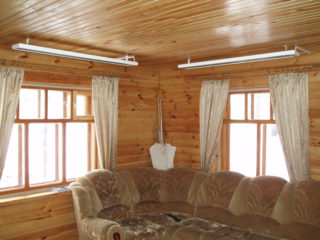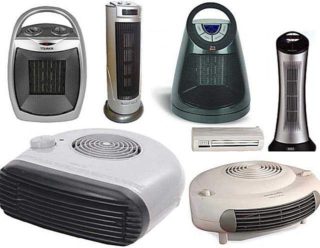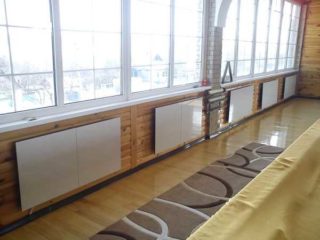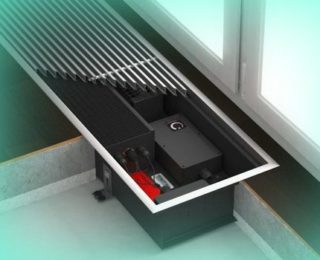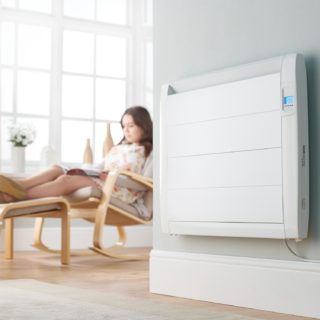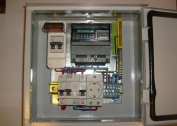Electric convectors are a special system designed for space heating. The principle of operation of the devices is the uniform distribution of heated air flows over the entire area. The structure consists of a heating element, which is enclosed in a housing equipped with slit-like openings. Such design features allow the flow of air to flow freely inside. Natural convection heats the air, but does not dry it.
Electric heaters and their advantages
Electric floor radiators are in great demand among the population. They are used to heat homes, apartments, cottages and work offices. This is due to a rather extensive list of advantageous features.
- You can start operation immediately after purchase.
- Reasonable cost in comparison with expensive radiators and boilers. The price of convectors ranges from $ 100 - $ 150.
- The maximum allowable coefficient of performance, which reaches 95%.
- There is no need to additionally spend money on the operation of the heating system during the operation. Also, there are no difficulties during installation.
- Exact maintenance of the set room temperature.
- Does not burn oxygen.
- There are no moving parts in the convector that can cause noise. The design works completely silently.
The service life declared by the manufacturers is, as a rule, true. The average operating life is 20-25 years.
The main disadvantage is the increased cost of electricity. Electricity consumption depends on the possible places of heat loss from the room: the quality of insulation, the area of windows and doors, such as installed double-glazed windows.
Types and types of radiators
The range of electric convectors and their functionality is characterized by a wide variety. This group includes all modifications equipped with fins, since it is such a casing that allows the most efficient distribution of heat.
All electric radiators are divided into two large groups: liquid-free and liquid.
Depending on the installation location, electric radiators are divided into the following types:
- floor;
- ceiling;
- wall mounted.
There are other types of designs: ceramic, glass, floor and skirting.
By design features, electric heating batteries are classified into the following types:
- infrared heaters;
- fan heaters;
- oil.
By the method of execution, the designs are divided into portable and stationary.
Liquid heat convectors
The main characteristic feature of this type is ease of execution, a small number of parts are included. The convector is heated thanks to a tubular electric heater of medium power, which ranges from 300-500 watts.
There are more powerful modifications. The heating elements are placed in an oily, aqueous medium or in a non-freezing liquid.
The work is silent. For safety reasons, it is important that the hot surface does not come into contact with flammable surfaces.
Liquid-Free Electric Batteries
Liquid-free and dry electric batteries are light in comparison with liquid counterparts and also heat up faster.
In these modifications, there is no intermediate coolant, therefore, heat transfer occurs from the heater to the heat transfer surface directly. The work is based on the principle of convection.
Floor electric radiators
Located on the floor. They belong to a large group of hidden heating systems. Their advantage is high efficiency and maintaining useful area.
Heating is due to the creation of a hot-air curtain on the path of penetration of cold air through the most vulnerable places. The principle of operation is similar to the operation of convective heating.
Criterias of choice
When choosing electric radiators, you should pay attention to the following criteria:
- Decide on the installation location. There are two ways to install equipment - floor and wall. Almost every wall-mounted modification can be converted into a floor, equipping it with stable legs. Sometimes they do it differently - they remove the legs from the floor structures and hang them on the wall.
- Find out what tasks an electric convector is needed for. In this case, we are talking about the room in which the structure will work. For example, if the heating system is installed in a utility room or cottage, the appliance must be equipped with the anti-freeze function and / or resistance to low temperatures. If you neglect this, most likely, from year to year you will have to purchase new heating convectors. If the design is designed to heat a residential building, apartment, you can do with the simplest modifications.
- Power. Not only the convector heating rate, but also the amount of electricity consumed depends on this factor. In this case, you need to give preference to devices that will be powerful for heating the room, but at the same time economical. For example, with a consumption of 500 W / h, it will be possible to warm up a room with an area of 20-25 square meters.
- You need to pay special attention to the electronic filling and the materials used in the manufacture. Most models are made of aluminum. Relying on a trusted manufacturer is better, otherwise you can buy a radiator of dubious quality.
- Temperature control. The device can be with a thermostat to control the temperature of the coolant, or monitoring the temperature of the air around. In order to save, it is preferable to choose the latter option.
In conclusion, it is worth mentioning also the equipment with various options. This item is unprincipled, it all depends on the budget.
Save energy without losing quality
It is worth highlighting the significant reasons why it is necessary to install electric heating at home.
- Creating a multi-section heating system will not cost too much, but the room will be well heated in the shortest possible time. It is worth mentioning separately about the installation, which does not cause difficulties even for beginners in this matter.
- A closed heating system creates a favorable microclimate for households, and does not attract dust. Electrical designs are compact and do not occupy large areas.
- Installation of radiators near windows minimizes heat loss through window cavities.
- In severe frosts, this is a quality analogue of traditional batteries. Often used in accidents.
- The system works from a universal power source under a voltage of 220 V.
It is worth noting the absolute safety of the heating system used. This is due to the use for the manufacture of high-quality and environmentally friendly materials.

